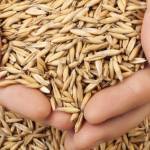Best Horse Feed: Plain Oats or Fortified Feed?

Imagine a fellow horse owner sends you this Facebook message: “Why do you feed oats instead of sweet feed?”
You ponder the question a moment, reeling off reasons in your mind: the horses love oats, a 50-lb sack of oats is less expensive than a bag of sweet feed, and horsemen have been feeding oats for a long time with no issues whatsoever. Right?
So you message back this response: “Tasty, inexpensive, proven. What’s not to love?”
You hear nothing more from your friend about this but notice one day that her feed bin at the boarding stable is filled to the brim with a sweet-smelling textured feed instead of the usual oats. What could she have discovered about plain oats that caused her to switch?
What do you think?
This scenario was presented to Catherine Whitehouse, M.S., a nutrition advisor with Kentucky Equine Research (KER), for her perspective.
“First, there’s nothing whatsoever wrong with good-quality plain oats,” Whitehouse said. “Oats and other cereal grains form the basis of many, many textured and pelleted feeds, as they provide significant energy and other nutrients. Oats are a key ingredient in many KER-formulated feeds.”
Aside from their nutritional benefits, oats have another significant attribute: palatability. “Second, as mentioned, horses are extremely fond of oats, and you’d be hard-pressed to find a horse that didn’t eat them. Occasionally, I’ve seen horses familiar with sweet feeds initially refuse plain, molasses-free oats, but usually these horses come around quickly,” she remarked.
When fed with appropriate forage, such as pasture or hay, oats provide energy to horses for maintenance of body condition. A diet composed of only forage and oats does not, however, provide optimal nutrition to most horses, according to Whitehouse.
“Certainly, young horses require additional vitamin and mineral fortification for peak growth and development, as do pregnant and lactating mares, breeding stallions, and most performance horses,” she said. “A diet made up of only forage and oats would not, for example, provide sufficient protein for growth. Insufficient amino acids, specifically lysine, could adversely affect development of foals, weanlings, and yearlings. This would be true even if the forage were of premium quality.”
Because of this, horse owners prefer to buy oats and other grains blended into textured or pelleted feeds that have been fortified with sources of protein, vitamins, and minerals. Fortification is added based on the purpose of the feed. A feed intended for a weanling is much different than one developed for a mature horse in low- to mid-level exercise.
Is it possible to feed oats to horses and provide optimal nutrition?
Absolutely, according to Whitehouse, but the key is delivering protein, minerals, and vitamins another way, usually through the use of a balancer pellet for young, growing horses. Mature horses typically derive sufficient protein from forage but require other nutrients, so a vitamin and mineral supplement is usually fed.
“Managing the nutrition of horses is not ruled by absolutes, so it is possible to assemble a diet for horses through the use of various feedstuffs, including oats and several other energy sources such as fat and fermentable fiber. The crucial element lies in nutritional adequacy of the total diet for the individual horse, based on its age, body condition, metabolism, and health,” concluded Whitehouse.
Is an oat-based concentrate right for your horse? Contact a nutrition advisor at KER for a free nutrition evaluation.








